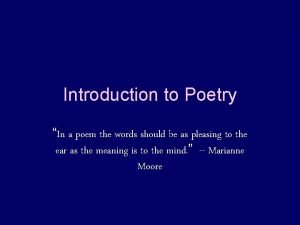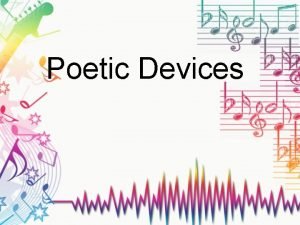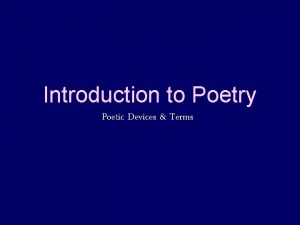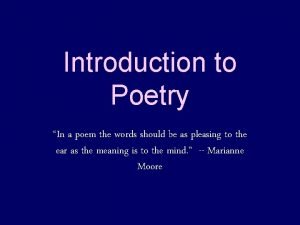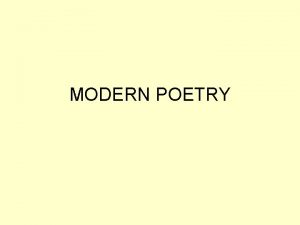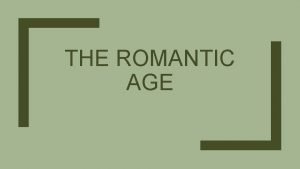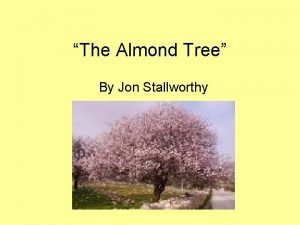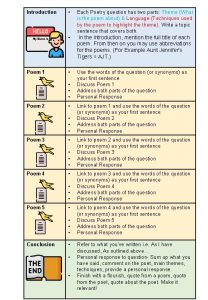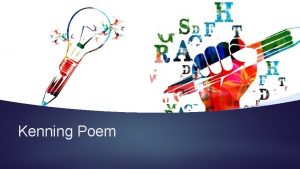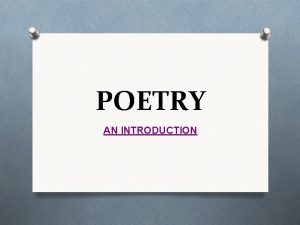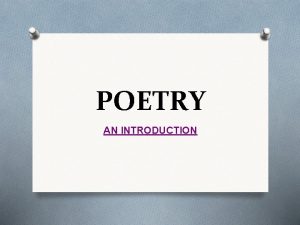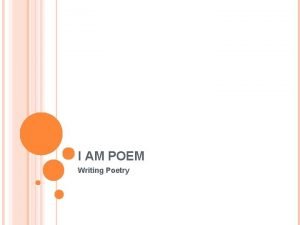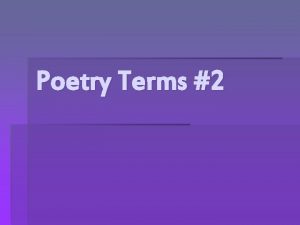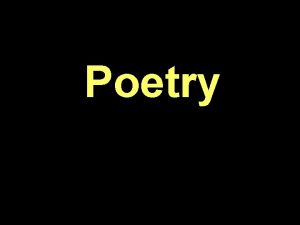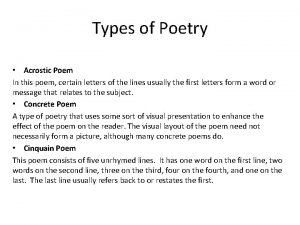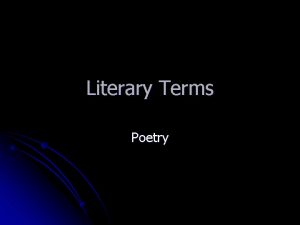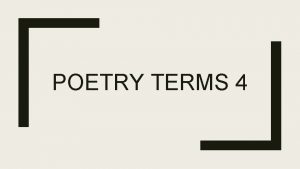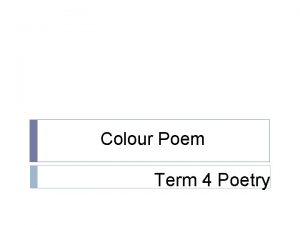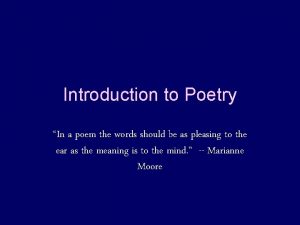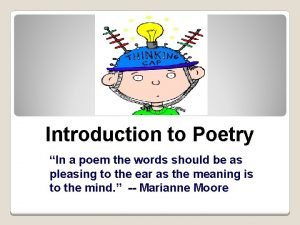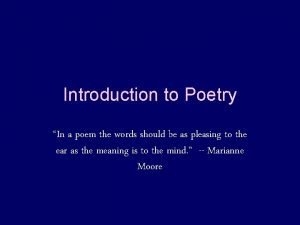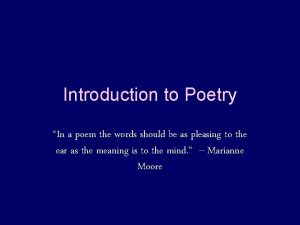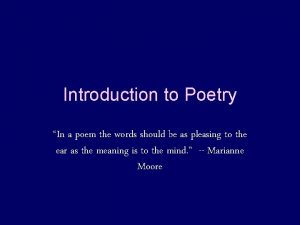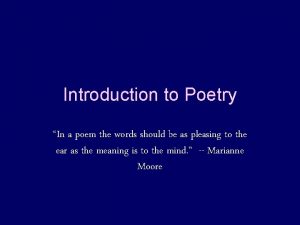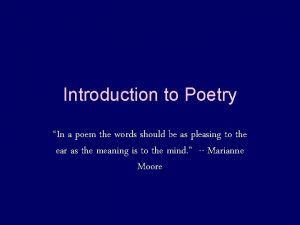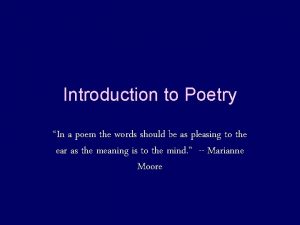Introduction to Poetry In a poem the words













































- Slides: 45

Introduction to Poetry “In a poem the words should be as pleasing to the ear as the meaning is to the mind. ” -- Marianne Moore Honors English 9

The Human Brain • Divided into 2 parts called hemispheres • Each half has its own function Left Brain: Logic Reality Right Brain: Creativity Emotions

When you’re looking at clouds in the sky. . . Your right brain tells you, “Hey! That one looks like Ms. Mc. Glynn’s dog. ” While your left brain tells you. . . It’s a cloud, Stupid!

What is a poem? Poetry is a form of literature that uses aesthetic (beauty) and rhythmic (beat) qualities of language to evoke meanings in addition to, or in place of, literal meaning

Rhyme the matching of vowel or consonant sounds at the end of two or more words (hat, cat, brat, fat, mat, sat) Not all poems rhyme Ex. “Richard Cory” by Edwin Robinson employs alternate rhyme, with the third line rhyming with the first the fourth line rhyming with the second: “Whenever Richard Cory went down town, We people on the pavement looked at him; He was a gentleman from sole to crown Clean favored and imperially slim. ”

Rhythm The effect(s) of the poem’s combinations of sounds The recurrence of accent or stress in lines of verse. Ex. “Same in Blues” by Langston Hughes “I said to my baby, Baby take it slow… Lulu said to Leonard I want a diamond ring”

Unstressed vs. Stressed iambic: Strong syllables (stressed) or softer syllables (unstressed) But, soft! What light through yonder window breaks? trochaic: Tyger, burning bright spondee: Downtown, hog-wild unstressed

Here’s a line to try… Write this line of poetry in your notes My mistress’ eyes are nothing like the sun Consider the meaning of this comparison. Which words are most important?

Identifying meter My mistress’ eyes are nothing like the sun Use an accent mark ( / ) to indicate syllables that get emphasized, and a shallow ( u ) symbol to indicate unstressed syllables. In a single syllable word, that’s easy. What about two syllable words? : / U / / My mistress’ eyes are nothing like the sun

Stanza a recurring unit of a poem version of a paragraph

Stanza Lengths Tercet: stanza of three lines Quatrain: a four line stanza Quintet: five line stanza Sestet: six line stanza Octave: eight line stanza

Refrain The repetition of one or more phrases or lines at the end of a stanza.

Couplet A pair of rhyming lines in a poem often set off from the rest of the poem. Shakespeare’s sonnets all end in couplets. }

End Rhyme Rhyming words that are at the ends of their respective lines—what we typically think of as normal rhyme.

Internal Rhyme Rhyming words that occur in the middle of their respective lines

Allusion A reference to something or someone often literary, religious, or historical For instance, if you were trying to instill confidence in a friend and said, “Use the force, ” that would be an allusion to Stars Wars. The verb form of allusion is to allude.

Anaphora repetition of the same word or group of words at the beginnings of successive clauses, establishing emphasis for emotional effect

Apostrophe a figure of speech sometimes represented by exclamation “O”. A writer or a speaker, using an apostrophe, detaches herself from the reality and addresses an imaginary character in his speech

Assonance The repetition of vowel sounds “Days wane away. ” Assonance: The rain in Spain falls mainly on the plain

Consonance The repetition of consonant sounds with changes in intervening vowels “linger” “longer” “languor” sometimes fits definition of slant rhyme

Caesura a strong pause in a line of poetry the pause can be indicated by punctuation, or the grammatical construction of the sentence, or the placement of lines on the page

Cacophony a harsh, discordant combination of sounds , often used to create a sense of disorder or an unpleasant feeling in the reader

Enjambment When there are no strong punctuation marks to end each line of verse and one line runs over onto the next without a pause from the French word meaning “to stride”

Elegy lyric poem mourning the dead often delivered in a closed form poem

Epigraph a brief quotation preceding prose or poetry that often sets the tone or highlights a particular theme of the text to follow I saw with my own eyes the Sibyl at Cumae hanging in a cage, and when the boys said to her: “Sibyl, what do you want? ” she answered: “I want to die. ”

Metapoetry that self-consciously takes poetry (the writing or reading of poetry) itself as its central theme

Free Verse Fog The fog comes on little cat feet. It sits looking over harbor and city on silent haunches and then, moves on. No Rhyme No Rhythm No Meter This is free verse.

Fixed Form a traditional form of verse with predetermined length, rhyme scheme, and meter, also called a closed form (sonnets, sestinas, villanelles, etc)

Euphony All euphony examples share the following features: 1. Euphony involves the use of long vowels that are more melodious than consonants. 2. Euphony involves the use of harmonious consonants such as “l, m, n, r” and soft “f” and “v” sounds. 3. Euphony uses soft consonants or semi-vowels “w”, “s”, “y” and “th” or “wh” extensively to create more pleasant sounds. Season of mists and mellow fruitfulness, Close bosom-friend of the maturing sun; Conspiring with him how to load and bless With fruit the vines that round the thatch -eves run; To bend with apples the moss’d cottage-trees, (Ode to Autumn by John Keats)

Villanelle a nineteen line lyrics poem that relies heavily on repetition the first and third lines alternate throughout the poem, which is structured in six stanzas of five tercets and a concluding quatrain

Sonnet a stanza of fourteen lines of iambic pentameter of Italian origin

Petrarchan Sonnet a stanza of fourteen lines of iambic pentameter

Elizabethan/Shakespearean Sonnet a stanza of fourteen lines of iambic pentameter of Italian origin

Sestina

Ode a long, stately poem in stanzas of varied length, meter, and form Usually a serious poem about an exalted (praiseworthy) subject

Ballad a narrative poem written in four line stanzas, characterized by swift action and narrated in a direct style

Free Verse Poetry with no set meter (rhythm) or rhyme scheme.

Unstressed vs. Stressed Strong syllables (stressed) or softer syllables (unstressed) pyrrhic: of the anapestic: When I widen the rent in my wind-built tent dactylic: FAB-u-lous or PO-et-ry unstressed

Meter The length of a line of poetry, based on what type of rhythm is used. o The length of a line of poetry is measured in metrical units called “FEET” o Each foot consists of one unit of rhythm. o If the line is iambic, trochaic, or spondaic, a foot of poetry has 2 syllables o If the line is anapestic or dactylic, a foot of poetry has 3 syllables

Line Lengths Each set of syllables is one foot, and each line is measured by how many feet are in it. The length of the line of poetry is then labeled according to how many feet are in it. 1: Monometer 5: Pentameter 2: Dimeter 6: Hexameter 3: Trimeter 7: Heptameter 4: Tetrameter 8: Octameter there are rarely more than 8 feet

She Walks in Beauty Reading this poem out loud makes the rhythm evident. Which syllables are more pronounced? Which are naturally softer? ˘ ΄ ˘ ΄ She walks in beauty, like the night Of cloudless climes and starry skies; And all that’s best of dark and bright Meet in her aspect and her eyes: Thus mellowed to that tender light Which Heaven to gaudy day denies. One shade the more, one ray the less, Had half impaired the nameless grace Which waves in every raven tress, Or softly lightens o’er her face; Where thoughts serenely sweet express, How pure, how dear their dwelling-place. And on that cheek, and o’er that brow, So soft, so calm, yet eloquent, The smiles that win, the tints that glow, But tell of days in goodness spent, A mind at peace with all below, A heart whose love is innocent! Count the syllables in each line to determine the meter. Examination of this poem reveals that it would be considered iambic tetrameter.

Blank Verse unrhymed iambic pentameter. The term iambic pentameter refers to the METER (the pattern of rhythm) in line of poetry. Iamb describes the unit of rhythm and pentameter describes the number of units

Why Blank Verse? Many playwrights chose to write in iambic pentameter in part because it is the natural rhythm of native English speakers most of the time. Blank verse is unrhymed iambic pentameter— most of us don’t speak in rhyme! Pay attention to when Shakespeare breaks form— characters who speak in rhyme or lines written in prose. Do you see any patterns?

Fill in missing syllables U / U / U / My mistress’ eyes are nothing like the sun U / = an iamb: an unstressed syllable followed by a stressed syllable How many iambs do you see?

Iambic pentameter 1 2 3 U 4 / U 5 / U / U / My mistress’ eyes are nothing like the sun 5 units = pentameter iamb describes the unit (U /)
 Poem introduction to poetry
Poem introduction to poetry Literary devices in introduction to poetry by billy collins
Literary devices in introduction to poetry by billy collins Diction in poetry examples
Diction in poetry examples Introduction to poetry poem
Introduction to poetry poem Define metaphysical poetry
Define metaphysical poetry Traditional poetry vs modern poetry
Traditional poetry vs modern poetry It is a poem which is comparatively short
It is a poem which is comparatively short Augustan age and romanticism
Augustan age and romanticism Almond trees poem
Almond trees poem Hát kết hợp bộ gõ cơ thể
Hát kết hợp bộ gõ cơ thể Frameset trong html5
Frameset trong html5 Bổ thể
Bổ thể Tỉ lệ cơ thể trẻ em
Tỉ lệ cơ thể trẻ em Gấu đi như thế nào
Gấu đi như thế nào Chụp tư thế worms-breton
Chụp tư thế worms-breton Hát lên người ơi alleluia
Hát lên người ơi alleluia Các môn thể thao bắt đầu bằng tiếng nhảy
Các môn thể thao bắt đầu bằng tiếng nhảy Thế nào là hệ số cao nhất
Thế nào là hệ số cao nhất Các châu lục và đại dương trên thế giới
Các châu lục và đại dương trên thế giới Công của trọng lực
Công của trọng lực Trời xanh đây là của chúng ta thể thơ
Trời xanh đây là của chúng ta thể thơ Cách giải mật thư tọa độ
Cách giải mật thư tọa độ 101012 bằng
101012 bằng độ dài liên kết
độ dài liên kết Các châu lục và đại dương trên thế giới
Các châu lục và đại dương trên thế giới Thể thơ truyền thống
Thể thơ truyền thống Quá trình desamine hóa có thể tạo ra
Quá trình desamine hóa có thể tạo ra Một số thể thơ truyền thống
Một số thể thơ truyền thống Cái miệng nó xinh thế
Cái miệng nó xinh thế Vẽ hình chiếu vuông góc của vật thể sau
Vẽ hình chiếu vuông góc của vật thể sau Nguyên nhân của sự mỏi cơ sinh 8
Nguyên nhân của sự mỏi cơ sinh 8 đặc điểm cơ thể của người tối cổ
đặc điểm cơ thể của người tối cổ V. c c
V. c c Vẽ hình chiếu đứng bằng cạnh của vật thể
Vẽ hình chiếu đứng bằng cạnh của vật thể Fecboak
Fecboak Thẻ vin
Thẻ vin đại từ thay thế
đại từ thay thế điện thế nghỉ
điện thế nghỉ Tư thế ngồi viết
Tư thế ngồi viết Diễn thế sinh thái là
Diễn thế sinh thái là Dạng đột biến một nhiễm là
Dạng đột biến một nhiễm là Thế nào là số nguyên tố
Thế nào là số nguyên tố Tư thế ngồi viết
Tư thế ngồi viết Lời thề hippocrates
Lời thề hippocrates Thiếu nhi thế giới liên hoan
Thiếu nhi thế giới liên hoan ưu thế lai là gì
ưu thế lai là gì
